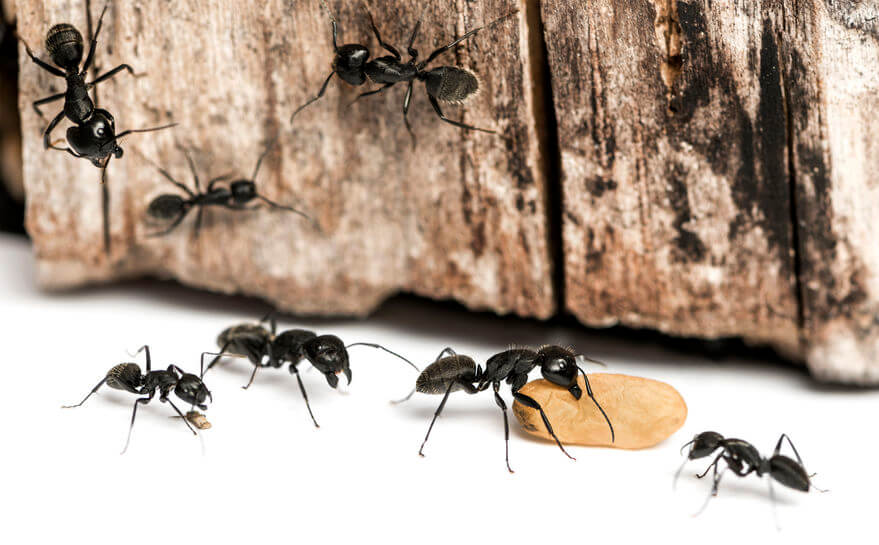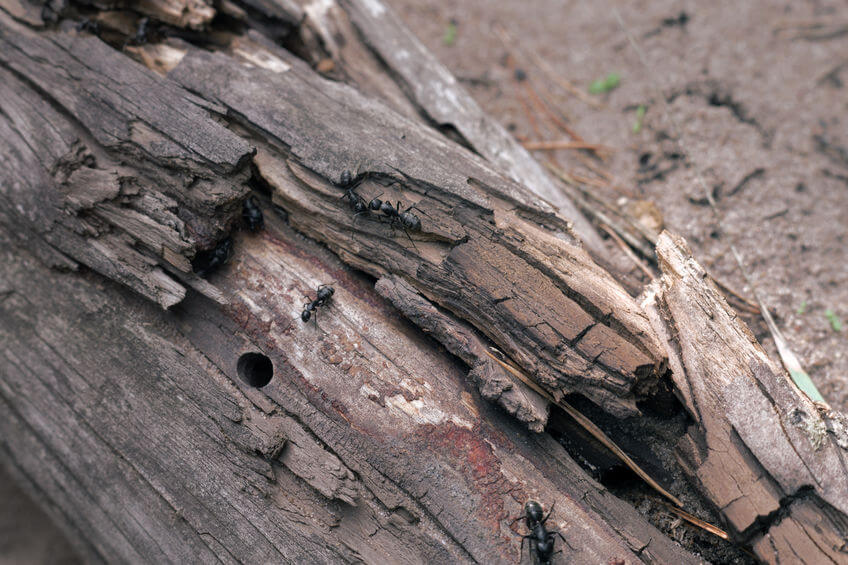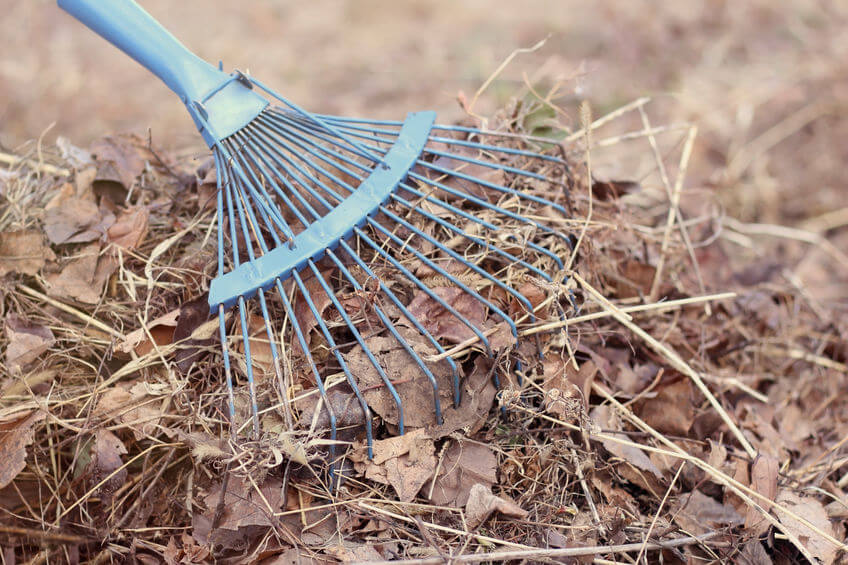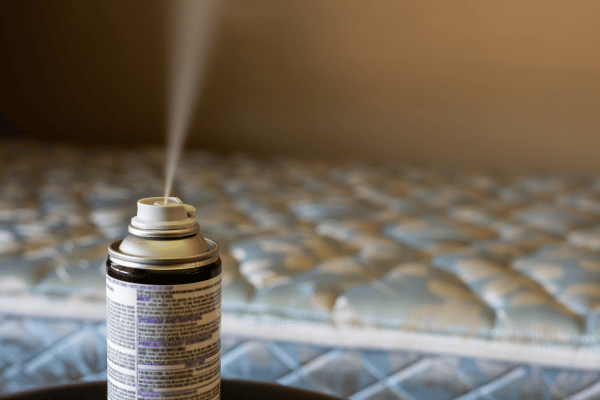- Home
- Indoor Pests
- Get Rid of Carpenter Ants
Get Rid Of Carpenter Ants
This post may contain affiliate links so I earn a commission.
It's not always easy to get rid of carpenter ants invading your home, mainly because they have the ability to expand their colonies rapidly.
Carpenter ants pose no known health risks, they don’t spread diseases like other insects, and they don’t bite or bother humans or pets.
They are just there.
A lot of them......and they are a nuisance that can be dealt with on many levels, from preventative care, to do-it-yourself pest control methods and products, or calling in the professionals if the situation gets out of hand.
What Do Carpenter Ants Look Like?
If you have seen multiple or winged ants in your home, the chances are pretty good they were carpenter ants.

One of the most popular ant types in North America, carpenter ants are also among the largest ant type, with the winged queen bee representing the largest.
Common characteristics of carpenter ants include:
- Red or black: Carpenter ants are either black or red, or both.
- Heart-shaped: The head of the carpenter ant has a distinctive heart shape to it, with angled antennae and large mandibles at the point of the heart.
- Round thorax: Unlike common garden ants and fire ants, the main body of the carpenter is rounded, not ridged.
- Single pedicle: While many ants exhibit multiple pedicles (body portions that connect to the head) carpenter ants have only one.
Get Rid Of Carpenter Ants - Swarmers
While you generally don’t think of ants having the ability to fly, these winged carpenter ants leave their home colonies to find a mate and create their own new colony.

“Swarmers” are larger than other carpenter ants and they're a good indication of a carpenter ant colony on your property.
Get Rid Of Carpenter Ants - Workers
Workers make up the majority of the population of carpenter ant colonies.
They are responsible for defending the nest, and feeding the queen and larvae.
Workers can range in size from ¼ inch to ½ long.
Where Do Carpenter Ants Live?
Carpenter ants thrive in dark, damp areas inside and outside, where they will build nests and satellite nests throughout your property.
Initial nests of carpenter ants are typically created in the decayed wood of tree stumps, piles of firewood, and rotting fence posts.

Colonies can spread indoors where carpenter ant nests are built in walls, attics, basements, and crawlspaces.
When signs are found inside, it is time to take action to get rid of carpenter ants.
Among the things to look for include:
- Swarmers: The more flying ants you notice around the baseboards or vents in your home, the larger the colony of carpenter ants that is likely spread indoors. They are typically most likely to be seen in the warmer spring and summer seasons.
- Crunching: Large nests of carpenter ants make a disturbing crunching noise when they rustle inside your walls.
- Sawdust: Carpenter ants build elaborate tunnel systems inside the wood framing of your home, leaving behind trails of sawdust leading back to their nest.
- Wood Damage: These tunnels in the wood can threaten the structural integrity of the framing. The tunnels are smooth, with a look as if they have been sandpapered.
Preventing Carpenter Ant Infestations
Like many pest control issues, the best way to get rid of carpenter ants is to create conditions inside and outside that prevent them from living on your property in the first place.

Steps to take to reduce the risk of carpenter ants infestations include:
- Cleaning the exterior and interior of your house
- Sealing off all cracks around the foundation, windows, and doors
- Storing all food sources
- Repairing any water leaks that may leave dripping or standing water
- Cut back trees and bushes that carpenter ants could use to get into your house
- Clean up or move wood piles and other natural debris that carpenter ants thrive in
How To Get Rid Of Carpenter Ants
Once carpenter ants have invaded your property, they can be difficult to get rid of.
Carpenter ants are nocturnal insects and they travel in small numbers, often making it difficult to detect until the problem grows.

Destroying one nest may only be the beginning of your carpenter ant infestation.
They build series of nests to ensure the colony will survive if one nest is destroyed.
There are a number of commercially sold ant baits and sprays that can be effective in keeping carpenter ants under control.
However, carpenter ants are tenacious and create systems of nests and satellite nests that can keep colonies going and growing if all of them are not destroyed.
Carpenter Ant Baits: Strategically place bait traps in the area where carpenter ants have been seen.
Ants will avoid baits put directly on their trails or directly on the ants themselves.

Baits should be checked regularly and replaced when needed or until you stop seeing carpenter ants in the area.
Common areas where bait placement can be most effective include:
- Kitchen cabinets and countertops
- Stove
- Drains, spouts, and sinks
- Pipes and cables on walls that lead to the outside
- Bathroom sinks, toilets, and shower areas
- Windows and door frames
Insecticides: Non-repellant ant sprays can take days to take full effect, but are more effective at wiping out colonies and nests of carpenter ants.

The insecticide sticks to passing ants and carries it with them back to the nest to infect the entire colony.
Dusts and Foams: If you know where the nests are and can access them through an opening in the wall or by drilling, dusts and foams will blanket entire areas infested with carpenter ants.
Get Rid Of Carpenter Ants Using A Professional
Carpenter ants pose no known health threat to you or your family.
They don’t spread any of the diseases some of their cohorts in the insect world can.
However, the products designed to kill carpenter ants can be very dangerous if used improperly or in unsafe conditions.
Commercially available carpenter ant control products can keep these nuisance pests at bay and may even be able to destroy their nests and disrupt their colonies.
If the problem persists or increases, only a professional pest control technician can thoroughly eradicate the most challenging carpenter ant infestations.



